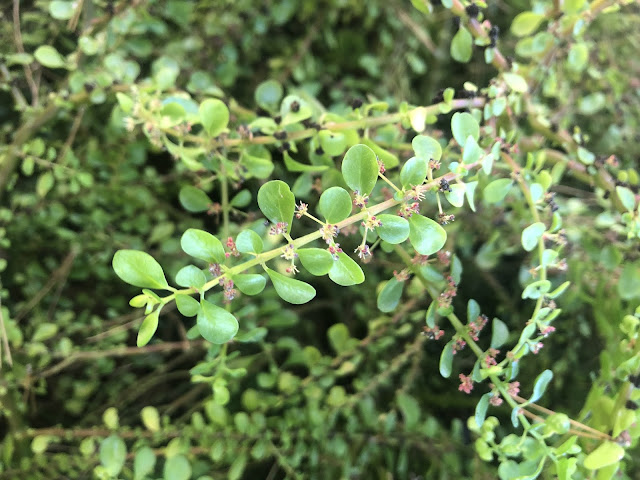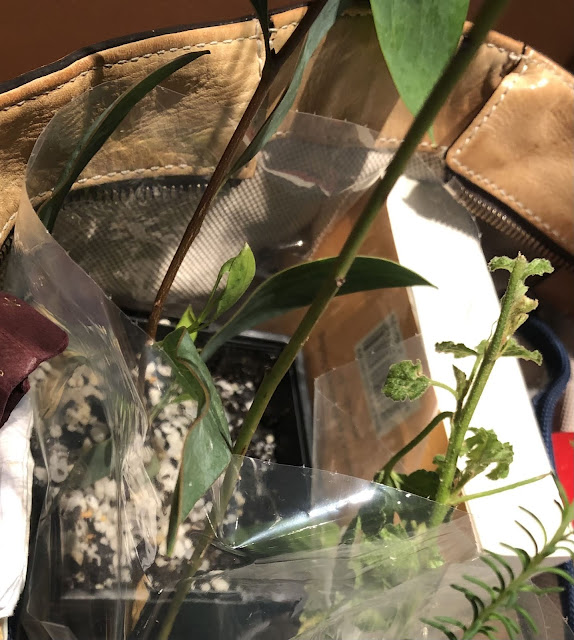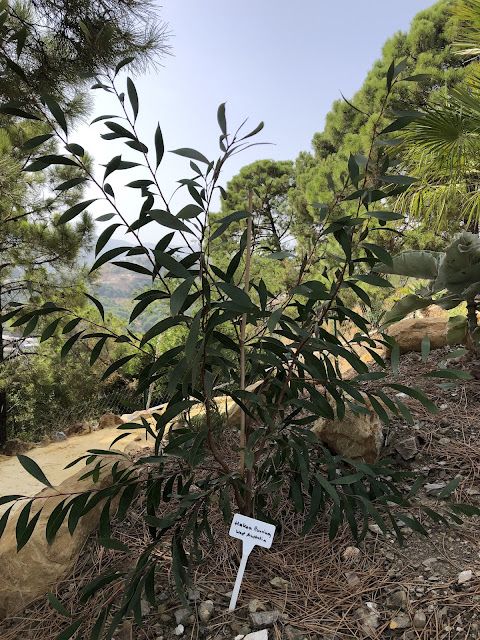Pilea microphylla
This versatile plant I brought from our summer vacation in 2018 on the island of Jamaica where I took a tour with the head gardener of the hotel which was surrounded by a beautiful large quasi-botanic garden. He gave me cuttings of Pilea microphylla and said, it was a "throw it, grow it" plant. It is exactly that: I potted it in soil in Germany in my study indoors and it grew roots immediately. I made more cuttings from that and planted them outside here in my garden in Andalucia. In English the plant is called "Artillery fern" (although it is not a fern at all, it belongs to the family of Urticacea, so is distantly related to our stingy nettles) and seems to be quite common and even invasive in some parts of the world, but I have never seen it sold anywhere. In my garden it is not invasive at all, I have not found any seedlings. It is a great easy ground cover for new empty soil. Its leaves are slightly succulent and it can survive many different conditions.
Anigozanthos flavidus
I am growing a few Australian plants that my daughter brought over when she returned from her studies in Sydney. She carried them either as little pots in her suitcases or as seeds all bought from the wonderful little plant shop in Sydney Botanic Garden.
Anigozanthos flavidus, the cangaroo paw plant, is easily grown from seed to make imposing plants within two years. I actually found smaller versions here in garden centers, but the one I grew from seed are the strongest and biggest and very effectual with long-lasting greenish-yellow flowers that reach 1,50 m high.
Their slender, sword-shaped leaves go well with plants with smaller leaves like salvias or dissected leaves like Geranium maderense.
Another Australian plant is Hakea laurina which my daughter gave me for christmas 2019. It thrives well here and has turned into a healthy bush with interesting leaves. We are hoping it will show its beautiful flowers next winter.
Clerondendron fragrans
Not always can I bring cuttings or seeds. Sometimes just an idea is enough, an encounter in a foreign garden, a scent, a beautiful leaf or interesting flower. Just like collecting memories by taking photographs of nice moments in time spent with friends, or travelling to new interesting places, I am trying to collect memories of scents that remind me of special moments by planting scented plants that make me relive those moments, or by choosing plants from certain geographies that may remind me of a summer vacation - souvenirs, like memories of a comforting warm hug or a pair of black eyes. Clerodendron fragrans is a plant I saw first in Israel in the garden beside the path to the entrance of the Israel Museum in Jerusalem. Its scent was so dramatic that I still remember it forty years on. I ordered a plant online which is sometimes difficult here in Spain as shipped plants don't survive long in their cartons if transport takes too long, which it does often. Mine is growing well and making a small thicket. The first flower has not opened yet and I am waiting to see if this is the correct plant - I have something much more whitish in my mind - and whether it carries the scent I remember.
Gardenia jasminoides
The brilliant Botanic Garden in Dallas grows huge Gardenia jasminoides in mostly shady groves underneath huge trees. When I found some here I planted them last autumn in a corresponding shady place on the east side of our terrain. So far they like it, have blossomed well and are growing a new layer of leaves this summer.
Delonix regia can be an imposing tree, red flowered with finely structured leaves that I noticed on Jamaica but also in Israel forty years ago. We planted one on our lawn expecting it to create a umbrella-style shady area in front of the terrace. Last winter was very tough here, with high winds and an unsual amount of rain and it did not like it one bit and lost all its leaves - but it returned in May with the heat and is thriving now in our summer here. Several winters will be needed to see if it will survive the conditions on our hillside and grow into the desired natural shape of a wide shade-giving umbrella.
Pandanus utilis
I met this imposing plant on the St Geran golf course on Mauritius. Sadly the golf course does not exist anymore, holiday villas have been constructed and I hope the plant decorates a garden now. Here we planted a large bush with many stalky aerial roots. Its leaves appear in a characteristic spiral.
I found seeds of Eryngium pandanifolium which I tried just for the name to compare what its leaves would look like. I had read that it is supposed to be the most imposing Eryngium. I am not sure about that, but the leaves are beautiful and the striking upwards reaching flowers are always full of bees.
Coffea arabica
Other ideas I get from books: Tania Blixen's efforts in the wonderful movie "Out of Africa" starring Meryl Streep who creates a coffee plantation on the slopes of Mount Kilimandscharo made me try a Coffea arabica plant. The first sample that I received here got a severe sunburn and withered within a day. I tried again and covered the second until it has adjusted - we will see (or "vamos a ver" in Spanish), whether I will be able to show pictures in a year. And hopefully I will have travelled again and have brought other species for my garden. There is still plenty of space.



























